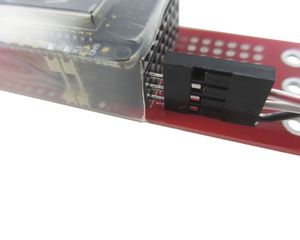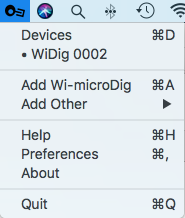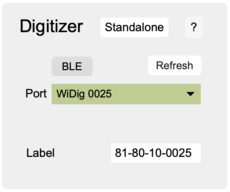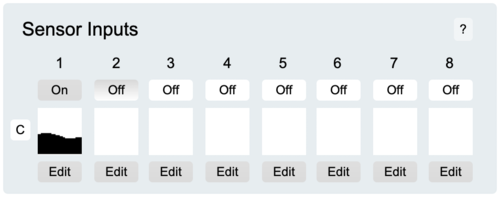Difference between revisions of "EditorX-81 QuickStart WiDig USB"
(→Connecting to the WiDig) |
|||
| (10 intermediate revisions by the same user not shown) | |||
| Line 3: | Line 3: | ||
For this walkthrough, you will need: | For this walkthrough, you will need: | ||
| − | *A WiDig and its drivers (see below). | + | *A [[WiDig]] (with included micro USB cable) and its drivers (see below). |
*A Turn (or other) sensor for testing. | *A Turn (or other) sensor for testing. | ||
*[http://icubex.com/editorx EditorX software]. | *[http://icubex.com/editorx EditorX software]. | ||
| Line 13: | Line 13: | ||
==Installing the WiDig== | ==Installing the WiDig== | ||
| − | + | '''1.''' Connect the [[WiDig]]'s micro USB port via the supplied micro USB cable to a USB port on the computer. It's possible to use any other micro USB cable but some cables can be of inferior quality such that the power supply to the WiDig is insufficient which may result in the inability to communicate with the WiDig. | |
| − | On both Windows and MacOS, to communicate via USB, you'll first need to add the WiDig as a virtual serial (or COM) port by installing its [http://icubex.com/silabs SiliconLabs driver]. If your operating system is not the most recent version, you may need to install an [https://www.silabs.com/community/interface/knowledge-base.entry.html/2017/01/10/legacy_os_softwarea-bgvU older driver]. | + | The WiDig is pre-configured to communicate via Bluetooth (or via WiFi if you've changed the [[WiConnect]] firmware to use WiFi instead), even though it can still communicate via USB but at MIDI data rate of 31.25 kbps. Once you've successfully connected with [[Connect]] or [[EditorX|EditorX]] to the WiDig you will be able to set the WiDig to communicate via USB only, at the higher data rate of 115.2 kbps. |
| + | |||
| + | |||
| + | '''2a.''' On both Windows and MacOS, to communicate via USB, you'll first need to add the WiDig as a virtual serial (or COM) port by installing its [http://icubex.com/silabs SiliconLabs driver]. If your operating system is not the most recent version, you may need to install an [https://www.silabs.com/community/interface/knowledge-base.entry.html/2017/01/10/legacy_os_softwarea-bgvU older driver]. Keep this driver up to date ! If you encounter communication problems lateron (eg. after an operating system update), updating or simply re-installing this driver may solve them. | ||
On MacOS, the drivers were installed correctly if the connected WiDig is listed in System Report (under About this Mac), in the USB section under Hardware. There should be an entry "CP2104 USB to UART Bridge Controller". | On MacOS, the drivers were installed correctly if the connected WiDig is listed in System Report (under About this Mac), in the USB section under Hardware. There should be an entry "CP2104 USB to UART Bridge Controller". | ||
| Line 23: | Line 26: | ||
On MacOS Sierra or higher, make sure to [https://developer.apple.com/library/archive/technotes/tn2459/_index.html allow the driver extension] in the "Security & Privacy" panel of the System Preferences, within 30 minutes after installation (or else re-install the drivers if MacOS doesn't show a way to allow the driver). | On MacOS Sierra or higher, make sure to [https://developer.apple.com/library/archive/technotes/tn2459/_index.html allow the driver extension] in the "Security & Privacy" panel of the System Preferences, within 30 minutes after installation (or else re-install the drivers if MacOS doesn't show a way to allow the driver). | ||
| − | |||
| + | '''2b.''' On Windows, [http://icubex.com/loopmidi LoopMIDI] virtual MIDI port software needs to be installed as well. There's no need to create any ports in LoopMIDI, nor does the LoopMIDI system tray app need to be running. | ||
==Connecting to the WiDig== | ==Connecting to the WiDig== | ||
| − | + | '''3.''' Connect the Turn sensor (or any other sensor) to input #1 of the WiDig as shown below, with the red wire on top and the black wire on the bottom. | |
[[File:WiDig-100.plug.800x640.jpg|300px]] | [[File:WiDig-100.plug.800x640.jpg|300px]] | ||
| − | + | '''4.''' Start [[Connect]]. On MacOS it may be necessary to [https://support.apple.com/en-ca/HT202491 add a security exception] in order to open it. On Windows Connect must be running before starting EditorX in order for EditorX to recognize the MIDI port(s) that Connect creates. | |
| Line 40: | Line 43: | ||
| − | + | '''5.''' On MacOS, click on the Connect icon in the menu bar. The WiDig entry with matching serial number should be listed in Connect's menu, with a dot in front of its name. If not, click Refresh Devices on the menu. | |
| − | On Windows, right-click on the Connect icon in the system tray. The WiDig entry with matching serial number should be listed in Connect's menu. | + | On Windows, right-click on the Connect icon in the system tray. The WiDig entry with matching serial number should be listed in Connect's menu. If not, click Refresh in the main window. |
On either MacOS or Windows, click on the WiDig entry to open the digitizer view to further inspect the WiDig's status. | On either MacOS or Windows, click on the WiDig entry to open the digitizer view to further inspect the WiDig's status. | ||
| Line 53: | Line 56: | ||
| − | + | '''6.''' Start EditorX. On MacOS it may be necessary to [https://support.apple.com/en-ca/HT202491 add a security exception] in order to open it. Note that on MacOS, the next time you run EditorX and Connect isn't already running, Connect should be started automatically when starting EditorX. | |
| Line 59: | Line 62: | ||
| − | + | '''7.''' In the [[EditorX-81_Digitizer | Digitizer section]] at the top, choose the WiDig with matching serial number. Upon connecting, the port menu will turn green. If EditorX failed to connect to the WiDig, maybe the Connecting section on the [[EditorX-81_Digitizer | Digitizer]] page can help you resolve the issue. | |
| Line 65: | Line 68: | ||
| − | + | '''8.''' Click the "Off" button under number "1" in the Sensor Inputs section to turn on sampling of sensor input 1. The box right below the button will show the sensor value if changed. If it doesn't show anything, click the "Clear" button in the Settings section at the top right of EditorX, and try again to turn on the sensor input. | |
| Line 71: | Line 74: | ||
| − | + | '''9.''' You're up and running. For further details about using EditorX, refer to the [[EditorX-81 |EditorX help pages]]. | |
Latest revision as of 20:10, 4 October 2021
What you need
For this walkthrough, you will need:
- A WiDig (with included micro USB cable) and its drivers (see below).
- A Turn (or other) sensor for testing.
- EditorX software.
- Connect software (included in the EditorX software package).
- SiliconLabs driver
- LoopMIDI (Windows only)
Installing the WiDig
1. Connect the WiDig's micro USB port via the supplied micro USB cable to a USB port on the computer. It's possible to use any other micro USB cable but some cables can be of inferior quality such that the power supply to the WiDig is insufficient which may result in the inability to communicate with the WiDig.
The WiDig is pre-configured to communicate via Bluetooth (or via WiFi if you've changed the WiConnect firmware to use WiFi instead), even though it can still communicate via USB but at MIDI data rate of 31.25 kbps. Once you've successfully connected with Connect or EditorX to the WiDig you will be able to set the WiDig to communicate via USB only, at the higher data rate of 115.2 kbps.
2a. On both Windows and MacOS, to communicate via USB, you'll first need to add the WiDig as a virtual serial (or COM) port by installing its SiliconLabs driver. If your operating system is not the most recent version, you may need to install an older driver. Keep this driver up to date ! If you encounter communication problems lateron (eg. after an operating system update), updating or simply re-installing this driver may solve them.
On MacOS, the drivers were installed correctly if the connected WiDig is listed in System Report (under About this Mac), in the USB section under Hardware. There should be an entry "CP2104 USB to UART Bridge Controller".
On Windows, the drivers were installed correctly if the WiDig is listed in the Device Manager (select from the menu that appears after right-clicking on the Start menu) as a serial port with name "COM..".
On MacOS Sierra or higher, make sure to allow the driver extension in the "Security & Privacy" panel of the System Preferences, within 30 minutes after installation (or else re-install the drivers if MacOS doesn't show a way to allow the driver).
2b. On Windows, LoopMIDI virtual MIDI port software needs to be installed as well. There's no need to create any ports in LoopMIDI, nor does the LoopMIDI system tray app need to be running.
Connecting to the WiDig
3. Connect the Turn sensor (or any other sensor) to input #1 of the WiDig as shown below, with the red wire on top and the black wire on the bottom.
4. Start Connect. On MacOS it may be necessary to add a security exception in order to open it. On Windows Connect must be running before starting EditorX in order for EditorX to recognize the MIDI port(s) that Connect creates.
5. On MacOS, click on the Connect icon in the menu bar. The WiDig entry with matching serial number should be listed in Connect's menu, with a dot in front of its name. If not, click Refresh Devices on the menu.
On Windows, right-click on the Connect icon in the system tray. The WiDig entry with matching serial number should be listed in Connect's menu. If not, click Refresh in the main window.
On either MacOS or Windows, click on the WiDig entry to open the digitizer view to further inspect the WiDig's status.
6. Start EditorX. On MacOS it may be necessary to add a security exception in order to open it. Note that on MacOS, the next time you run EditorX and Connect isn't already running, Connect should be started automatically when starting EditorX.
7. In the Digitizer section at the top, choose the WiDig with matching serial number. Upon connecting, the port menu will turn green. If EditorX failed to connect to the WiDig, maybe the Connecting section on the Digitizer page can help you resolve the issue.
8. Click the "Off" button under number "1" in the Sensor Inputs section to turn on sampling of sensor input 1. The box right below the button will show the sensor value if changed. If it doesn't show anything, click the "Clear" button in the Settings section at the top right of EditorX, and try again to turn on the sensor input.
9. You're up and running. For further details about using EditorX, refer to the EditorX help pages.






